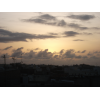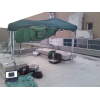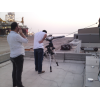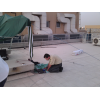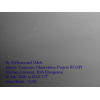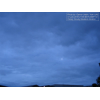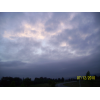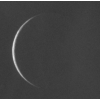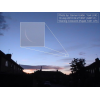Visibility of Sha'ban Crescent 1431 AH
- When to Observe Sha'ban Waxing (NEW) Crescent ?
- Sha'ban Waxing (NEW) Crescent Observation Results
- The OFFICIAL First Day in Different Countries
- When to Observe Rajab Waning (OLD) Crescent ?
- Rajab Waning (OLD) Crescent Observation Results
When to Observe Sha'ban Waxing (NEW) Crescent ?
The geocentric conjunction (Geocentric New Moon) will occur Inshalla on (Sunday 11 July 2010) at 19:40 UT.
Sighting the new crescent on (Sunday 11 July 2010) and (Monday 12 July 2010) is shown in the below graphs using the program Accurate Times by Mohammad Odeh according to Odeh criterion. Where:-
- It is impossible to see the crescent from the areas located under the red color. Because either the Moon on this day sets before the Sunset and/or the topocentric conjunction occurs after the Sunset.
- The crescent is expected to be seen by optical aid only from the areas located under the blue color.
- The crescent is expected to be seen by optical aid from the areas located under the magenta color. In these areas the crescent could be seen by naked eye if the atmospheric conditions are superb and the observer is experienced.
- The crescent is expected to be easily visible by naked eye from the areas located under the green color.
- The crescent cannot be seen from uncolored areas, even though the Moon sets in these locations after the Sunset and the topocentric conjunction occurs before the Sunset, but the Moon is not sufficiently illuminated in order to be seen as crescent even by optical aid.
- Kindly notice that the below graph shows the possibility of seeing the crescent from areas between 60 degrees north of Equator down to 60 degrees south of Equator.
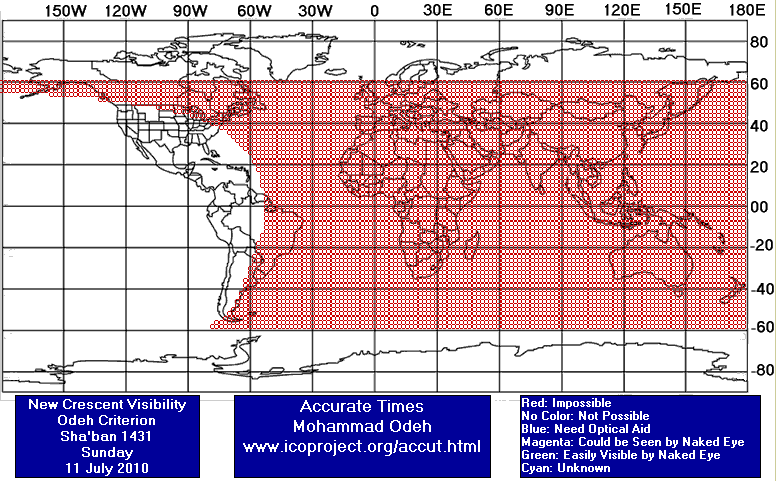
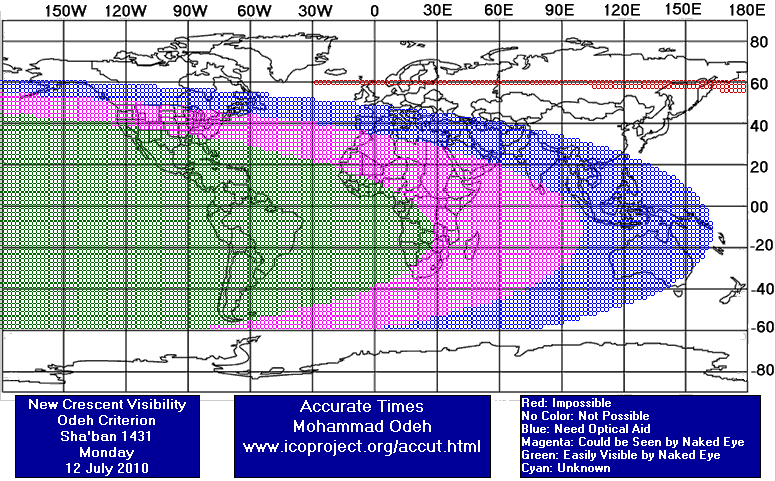
According to the Universal Hejric Calendar (UHC), which is based on the calculated crescent visibility, the start of this month in the Eastern Region will be on Tuesday 13 July 2010 and in the Western Region will be on Tuesday 13 July 2010. Kindly notice that the UHC is a pre-calculated calendar, which adopts a certain criterion to start the new Hejric month. Your country/organization might adopt different criterion to start the new Hejric month. So it is highly advised to read the UHC website before giving any judgment.
- Results of seeing the crescent, and the first day of the month in different countries will be added here Inshalla as we receive the reports from ICOP's members. If you wish to be a member in ICOP, or to know more about it, kindly click here.
Sha'ban Waxing (NEW) Crescent Observation Results
Mon 12 July 2010
Algeria
Mr. Hocine Chikh Aissa said: "(04) persons were present in n'tissa station and have tried to observe the SHABAN 1431 crescent but it wasn't seen. The western horizon was hazy. They have used binocular: 7*50." "
Bangladesh
Germany
Eng. Martin Elsaesser said: "Skies were hazy, with thunderstorms forming. I tried for one hour to see the crescent visually with two different telescopes, about 3 hours BEFORE sunset. Despite looking at the correct spot and trying several filters, i could not see the crescent due to the haze. The planets Mercury, Venus, Mars and Saturn could be found with no problem. In the evening, the clouds had covered most of the sky, so no chance after sunset."
Lebanon
Mr. Ibrahim Merhebi said: "The moon should have been very close to the Sun, for it was not seen due to the high solar illuminance or brightness. Observation was attempted at random intervals between 1800 hrs & 1930 hrs. The result of not detecting the crescent might be to either the solar illuminance or lack of a good observing location."
Malaysia
Nigeria
Mr. Qamarudeen Muhammad said: "We couldnt see the new Hilal as result of cloudy sky"
Mr. Usman Dukku said: "In spite of the thin clouds over the western horizon, we attempted sighting the crescent but we did not see it."
Oman
Prof. Mohammed Al-Bussaidi said: "We could not see the crescent Moon due to very hazy (dusty condition) and also the weather was extremely hot at 44 C. "
Pakistan
Mr. Alam Sultan said: "Today (Monday, 12 July 2010 = 29 Rajab 1431 in Pakistan), on my request nearly 200 persons (members of the moon-sighting committees of our institute "JAMIA-TUR-RASHEED" + my friends + their companions) tried to sight the moon at more than 30 places all over Pakistan but the moon could not be sighted, as it was expected tonight. Almost it was full cloudy all over Pakistan. Note 1: Today (Monday, 12 July 2010) the conditions of the moon were so defective in most Asia especially in whole Pakistan etc that according to the all old and new criteria of moon-sighting, there was no solid proof in the history of astronomy to sight such a moon by naked eyes. Note 2: In the absence of the Chairman, the vice-chairman of central official moon sighting committee of Pakistan told me on my mobile phone that as he also did not receive any positive report countrywide therefore he announced officially that Tuesday 13 July is 30th Rajab and Wednesday 14 July 2010 is 1st Shabaan1431 in Pakistan. Note 3: After some days, inshaallah, a detailed report of this observation in Urdu will be available at www.esnips.com/web/moonnewsofjamiaturrasheed "
Saudi Arabia
Mr. Bander Albotehy said: "The crescent on July 12, 2010 should be 6 degrees above the horizon and exactly above the crescent by 6 degrees Mercury should appear. However, both of them were not seen by naked eyes or any other tool from our location. The weather conditions (hot and humid) were not ideal. "
Mr. Saleh Al-Saab said: "The crescent was less than 7 degrees avove the horizon at sunset but the horizon was dusty."
Senegal
South Africa
Tanzania
Mr. Zaffar Sheriff said: "Conditions seemed ideal. Haze hanging low above western horizon prevailed throughout the 46 minute duration till moonset. The search was on till 7.07pm, the moonset time. Altitude 9.5 and elongation 10.5, young age of 19hrs 41min would have been one of interesting entries into our logbook. The crescent was not seen by anyone in our group of eight."
United Arab Emirates
Eng. Mohammad Odeh said: "This is our first trial to observe the crescent by CCD Camera using our new equipment. I've started the observation on Monday 12 July 2010 at 09: 30local time (UT+4). I made the observation from my company (CCC) from one of the building's roof! The alignment was done on Tuesday06 July...... Despite the very hot weather (max temperature 44 degrees C), I kept trying from09 : 30up to19 :30, with an hour break every 2 hours! I did more than 15 trials..... Although the crescent was expected to be seen as soon as I started the observation, I was only able to see it very few minutes before sunset.... The sun was almost setting at the time we saw the crescent! After the crescent was captured by the CCD camera using IR filter, we tried to see the crescent by telescope! But it was not seen neither by naked eye nor by telescope! It was only captured using the new technology (CCD Imaging). Thanks are due many friends who made this observation successful, namely: Ayman Qaddoumi, Khaled Natour, Mohammad Saleh, Osman Mawed, Ahmad Mawed, Issam Kouzi, Abdel Fettah Lahiouel , Amr Ashraf, Yamen Saleh, Ibrahim Barakat, and others... Each one had a role he did :-)!! "
United Kingdom
Eng. Qamar Uddin said: "On Monday 12 July 2010 (29 Rajab 1431 AH) many people from throughout UK have attempted to sight the crescent moon (Hilal) of Shaban after sunset. Most places were cloudy and so none of the groups were able to sight Hilal. However, we have received reliable sighting news (Muhaqaq Ruyat-e-Basari) from countries in the East of UK (including South Africa). Therefore, the Ulama have decided that the month of Rajab 1431 AH will have 29 days and the month of Shaban 1431 AH will start from Tuesday 13 July 2010 (which means the night of 14 Shaban will be on Monday 26 July 2010), Insha-Allah. May Allah rewards all those who have attempted to revive the Sunnah of moon sighting, this month."
United States
Dr. Javad Torabinejad said: "This evening (Monday, July 12, 2010), the crescent moon of Sha'ban was not sighted in Blacksburg, VA, using a pair of (7X50) binoculars. I arrived at the sighting location before sunset (sunset: 8:43 pm EDT) and started looking for the crescent in the opening patches of a mostly cloudy western horizon. Although the expected crescent location was cloudy for most of the time, I stayed there till 9:15 pm before moonset (moonset: 9:26 pm EDT)."
Tue 13 July 2010
Pakistan
Mr. Alam Sultan said: "On my request, Today (Tuesday 13 July 2010 = 30 Rajab 1431 in Pakistan) nearly 200 persons (Members of the moon-sighting committees of our institute "JAMIA-TUR-RASHEED" + my friends + their companions) tried to sight the moon at more than 25 places all over Pakistan and resultantly moon was easily seen in all four provinces at those places where the sky was partially cloudy or nearly clear. As many places were totally cloudy like Karachi therefore moon was not sighted there. It was officially announced yesterday that 1st Shaban 1431 is on Wednesday, 14 July 2010, in Pakistan. Note: After some days, inshaallah, a detailed report of this observation in Urdu will be available at www.esnips.com/web/moonnewsofjamiaturrasheed "
Saudi Arabia
Mr. Bander Albotehy said: "The crescent was seen easily from my home immediately after the sunset. "
The OFFICIAL First Day in Different Countries
Mon 12 July 2010
1 . Libya
Tue 13 July 2010
1 . Bahrain
2 . Egypt
3 . Indonesia
4 . Jordan
5 . Kuwait
6 . Malaysia
7 . Nigeria
8 . Oman
9 . Qatar
10 . Saudi Arabia
11 . South Africa
12 . United Arab Emirates
13 . United Kingdom
14 . United States
Wed 14 July 2010
1 . Morocco
2 . Pakistan
3 . Senegal
When to Observe Rajab Waning (OLD) Crescent ?
The geocentric conjunction (Geocentric New Moon) will occur Inshalla on (Sunday 11 July 2010) at 19:40 UT.
Sighting the OLD crescent on (Sunday 11 July 2010) and on (Saturday 10 July 2010) is shown in the below graphs using the program Accurate Times by Mohammad Odeh according to Odeh criterion. Where:-
- It is impossible to see the OLD crescent from the areas located under the red color. Because either the Moon on this day rises after the Sunrise and/or the topocentric conjunction occurs before the Sunrise.
- The crescent is expected to be seen by optical aid only from the areas located under the blue color.
- The crescent is expected to be seen by optical aid from the areas located under the magenta color.. In these areas the crescent could be seen by naked eye if the atmospheric conditions are superb and the observer is experienced.
- The crescent is expected to be easily visible by naked eye from the areas located under the green color.
- The crescent cannot be seen from uncolored areas, even though the Moon rises in these locations before the Sunrise and the topocentric conjunction occurs after the Sunrise, but the Moon is not sufficiently illuminated in order to be seen as crescent even by optical aid.
- Kindly notice that the below graph shows the possibility of seeing the crescent from areas between 60 degrees north of Equator down to 60 degrees south of Equator.
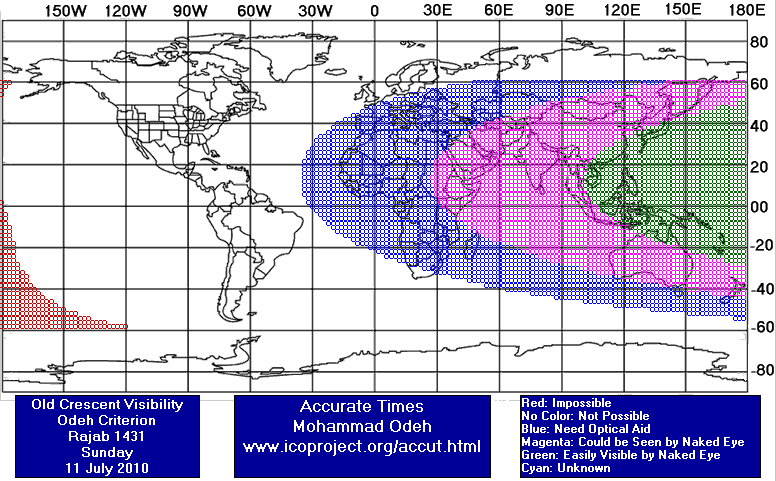
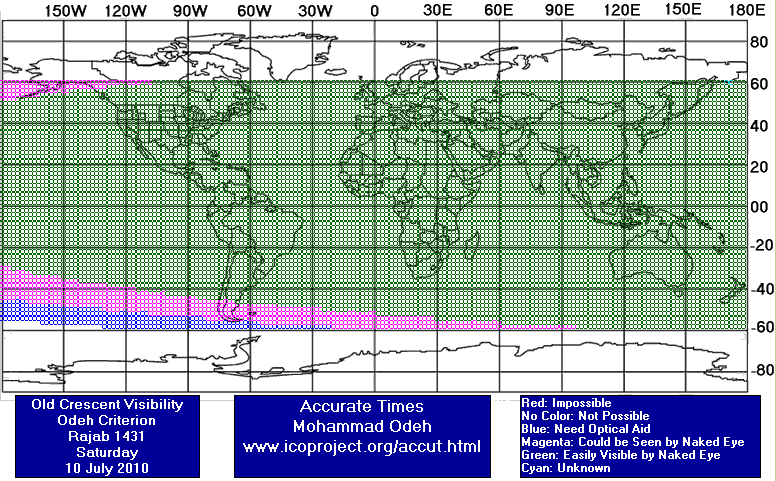
Rajab Waning (OLD) Crescent Observation Results
Sat 10 July 2010
Germany
Eng. Martin Elsaesser said: "I could not find the energy to observe the simple crescent during morning twilight, so i had to resort to daytime observation again. The crescent, still at 20° elongation from the sun, could easily be seen visually with a small telescope in the blue skies. A red filter somewhat improved contrast for visual observation. Imaging the crescent was also easy with a small telescope, with a deep-red filter and a good monochrome camera. By stacking hundreds of images, even the earthshine could be faintly detected. "
United Kingdom
Eng. Qamar Uddin said: "On Saturday 10 July 2010 (27 Rajab 1431 AH) I was able to sight the waning crescent moon after the morning (Fajr) prayer, before sunrise from the eastern horizon, Alhamdulillah. The sky was quite bright and hence it was quite difficult to locate the dim crescent. The attached photo was taken at about 25x optical zoom. Note that the period between the last waning crescent (Urjunil Qadim) and the first waxing crescent (Hilal) is called New Moon Phase (Mahaq) and the New Moon Conjunction (Iqthiran) takes place in between Mahaq! وَالْقَمَرَ قَدَّرْنَاهُ مَنَازِلَ حَتَّىٰ عَادَ كَالْعُرْجُونِ الْقَدِيمِ "And (for) the moon, We have measured for it mansions (to traverse) till it returns like the old dried curved date stalk." (Quran 36:39)"
Sun 11 July 2010
Germany
Eng. Martin Elsaesser said: "I tried to observe the difficult waning crescent visually during morning twilight with 25x100 binoculars. The weather was ok, but with some haze near the horizon. Due to late arrival at the observing site i could not locate the expected position of moonrise well, as the skies were already quite bright. I swept the horizon back and forth for half an hour, but could not locate the crescent, also having some problems with the instrument. So, to see such difficult crescents, the position needs to be known exactly and focus and alignment need to be spot on"
